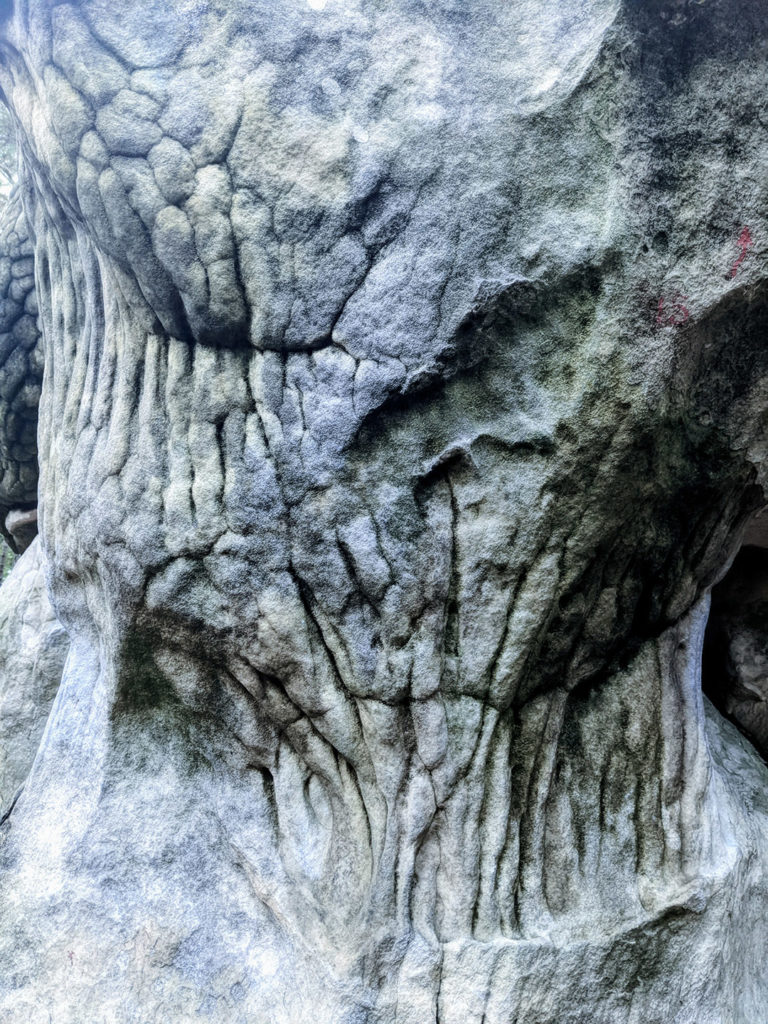La forêt de pierre

En me promenant dans la forêt de Fontainebleau et en regardant les rochers, j’ai découvert que mes dessins d’enfance et d’adolescence qui représentaient souvent, si ce n’est obsessionnellement, des corps humains dotés d’excroissance et de monstrueuses déformations, d’anomalies et qui se répétaient d’image en image, étaient sans doute inspirés de la vision à l’âge de 4, 5 et 6 ans, lorsque nous nous promenions avec nos parents, des rochers et de leurs circonvolutions.
En effet, devant l’un d’entre eux, j’ai cru reconnaitre exactement une forme que j’avais dessinée. Ces dessins n’étaient donc pas la représentation d’une dégénérescence corporelle et organique, mais d’un corps devenant pierre ou fossile, le mélange de la chair et de la pierre comme si l’un et l’autre appartenaient à d’autres temps.
Je me souviens qu’enfant en effet j’imaginais dans ces rochers, que j’adorais escalader, des animaux et des êtres humains, faisant jouer la pareidolie qui nous fait voir tout dans tout et qui fait circuler le monde dans une multiplicité d’autres.
Il ne s’agissait donc pas de l’horreur de son propre corps et de ce décalagequi nous saisit lorsque enfant nous découvrons la réflexivité de l’épiderme, mais bien d’une autre relation entre de règnes hétérogènes, le vivant et le minéral. Il y a souvent chez l’enfant le sentiment d’un immense dehors, du cosmos en son entier qui avale tout et chaque pierre, chaque feuille, chaque racine pourrait être le signe d’autres organismes comme si tout se fondait dans des flux tumultueux qui ne signifiait par une fusion homogène, mais la coexistence chaotique et fractale de tous les possibles.
Sans doute mon amour précoce pour Max Ernst et pour « l’Europe après la pluie » fut déterminé par la reconnaissance de cette forme minérale en appelant une infinité d’autres.

While walking in the forest of Fontainebleau and looking at the rocks, I discovered that my childhood and teenage drawings, which often represented, if not obsessively, human bodies with excrescences and monstrous deformations, anomalies and which were repeated from image to image, were undoubtedly inspired by the vision at the age of 4, 5 and 6, when we were walking with our parents, of the rocks and their convolutions.
Indeed, in front of one of them, I thought I recognized exactly a shape that I had drawn. These drawings were therefore not the representation of a bodily and organic degeneration, but of a body becoming stone or fossil, the mixture of flesh and stone as if both belonged to other times.
I remember that as a child I used to imagine animals and human beings in these rocks, which I loved to climb, bringing into play the pareidolia that makes us see everything in everything and that makes the world circulate in a multiplicity of others.
So it was not about the horror of one’s own body and this gap that seizes us when as a child we discover the reflexivity of the epidermis, but about another relationship between heterogeneous kingdoms, the living and the mineral. There is often in the child the feeling of an immense outside, of the cosmos in its entirety which swallows everything and each stone, each leaf, each root could be the sign of other organisms as if everything melted in tumultuous flows which did not mean a homogeneous fusion, but the chaotic and fractal coexistence of all the possibilities.
No doubt my early love for Max Ernst and for “Europe after the rain” was determined by the recognition of this mineral form calling for an infinity of others.

